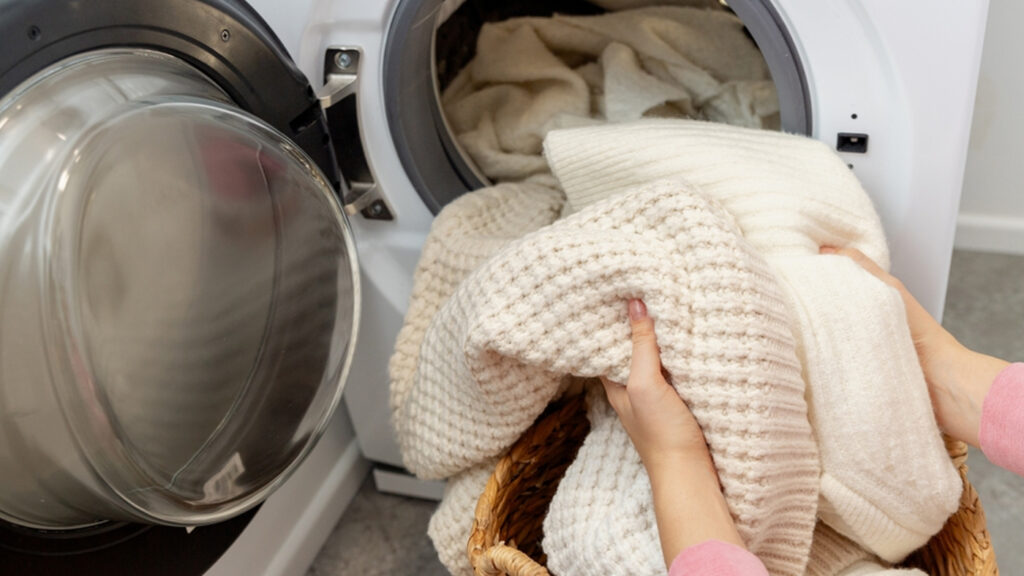
Wool has been a popular clothing material for thousands of years due to its permeable and absorbent properties, as well as its comfort, warmth, and style. Wool, when properly cared for, can endure a very long time, yet many people make the mistake of treating it like any other garment material. Whether it’s washing and drying your wool clothing at home to help it last longer or entrusting your delicates to a professional like LNDRY, we’re here to explain how to maintain your wool items in good shape for many years.
Wash Wool Sparingly
One of the advantages of wool clothing that many people don’t understand is that it doesn’t need to be washed as frequently as other items, which is great for the environment! Because of wool’s natural antimicrobial characteristics, you can wear your socks several times before washing them; the key is to air them out between usage.
Wool also has a natural protective layer that serves as a barrier, preventing stains from being absorbed. You should only wash your wool if it is physically soiled or emits any distinguishing scents, and even then, you should use a stain remover first.
Wash Wool by Hand
Though it is feasible to machine-wash some wool, many people prefer to do it by hand or have it professionally done to protect the fabric. To hand-wash wool, fill your sink or bathtub with tepid water and a tiny bit of wool-washing detergent. Allow your garment to soak for 10 minutes while gently swishing it around to avoid stretching the material. Remove as much extra water as possible without wringing out the wool, then rinse it in clean water. Gently wash the item again and repeat the rinse process until the detergent is completely gone. If you hire a professional to perform it for you, you’re in for a treat. Lndry provides pickup and drop-off services to make your laundry experience more convenient and enjoyable and cares for your clothes just the way you would.
Wash Wool in the Machine
Some brands make machine-washable wool garments, but even with these products, the fewer spin cycles you use, the longer your wool clothing will last. The secret is to use the appropriate detergent and only run slow, cold cycles. Soaking your wool garments in cold water before washing can help to decrease shrinkage. If your clothing is heavily stained or requires particular care, you should contact a professional cleaner like LNDRY, as our machines are specifically built to get the most out of wool. As an additional layer of protection, we frequently utilize a mesh laundry bag for delicate items and items with attachments such as removable straps, and metal or plastic embellishments, which you may also use at home. If your washer has a hand wash or wool cycle, use that; otherwise, select the slowest and coldest cycle feasible. Always check the label before washing anything in the machine. If the label specifies hand-wash only, even a hand-wash cycle in the machine can harm the clothing.
Dry Wool Carefully
Wool should never be dried unless it is a professional dryer; not only will it shrink your clothes, but it will also set any stains that were not removed during the washing process. After washing your wool, whether by hand or machine, place it flat on a towel to dry. To eliminate excess water, gently roll the garment in the towel into a tight cylinder. Unroll your clothing and lay it on a flat surface — never hang wool as it will cause lumpy, misshapen areas as it dries. While the garment is still damp, carefully reshape it as needed.

Store Properly
Many people store wool clothing in the same way they do normal clothing, which is a mistake. Always clean and vertically brush each wool item with a professional textile brush before storing it in a drawer; never on a hanger, since this may stretch the fibers in the incorrect direction and cause the knit to droop, affecting the fit. Moths are naturally drawn to the proteins in wool fibers, so store it with natural cedar wood balls to keep them away. You can also keep them in plastic bags or containers for extra protection.
So that’s all you need to know to properly care for your wool products. Follow this approach to keep your woolen items in good condition for a long period.



